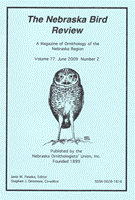Nebraska Ornithologists' Union

Nebraska Bird Review
Date of this Version
2019
Document Type
Article
Citation
The Nebraska Bird 118 Review Vol. 87 No. 4 (2019), pp 118-138
Abstract
By far the most striking feature of this fall’s report is the large number of lingering migrants, a trend that is continuing and apparently increasing, especially among passerines. Editor Jan Paseka counted 17 uses of the word “tardy” and 43 of “late” or “latest”. It is tempting to relate this to the warmer environment and resulting increased availability of food items at higher latitudes and later dates than in previous years. A sad note: a startling occurrence in Gering, Scotts Bluff 20 Aug was described by Marie Smith: “We had a huge hailstorm around 10:30. The hail was probably pea to quarter sized, but it was driven by what felt like tornadic winds. We went [downtown] this morning and collected 258 pounds of dead birds. I am estimating that 50% were American Robins, 35% were English Sparrows, 14% were House Finches, and 1% were Pine Siskins.” After some calculations using weights found online, the 258 lbs translates into at least 2000 and as many as 3300 birds. Perhaps of most interest are breeding records that are new to the state. First state breeding records were made by Black-bellied Whistling-Duck and Ring-necked Duck, contrastingly one ranging south and the other following recent trends of northward range expansions. Common Gallinules bred quite far to the north, and the first breeding record for Cattle Egret in the RWB, eighth overall for the state, was accompanied by important breeding records there of Eared Grebe and White-faced Ibis. Mississippi Kites bred in Lancaster for the first time, and dependent fledglings in late Oct were observed for Red Crossbill and Northern Cardinal. High numbers are often intriguing. The biggest surprise was the incredible number of reports of Canada Warbler; the 33 reports involved about 35 individuals. Carolina Wrens also spread out in numbers, with some 21 extralimital reports around the state. Lincoln hosted high counts of 1415 Chimney Swifts and 10,000 Purple Martins, both at roosts. A count of 200 Eastern Kingbirds was impressive. The 87 Red-breasted Nuthatches in Sowbelly Canyon suggested an invasion year, but the best count in the east was only four. Good numbers were reported of Red Crossbills, but only five Purple Finches and five Snow Buntings had appeared by the end of the period. Five Northern Saw-whet Owls were detected in Sowbelly Canyon.
Major rarities were few for a fall season, but of good quality. They included Nebraska’s first documented record of Mexican Duck, 6th Harris’s Hawk, 11th Longtailed Jaeger, and 15th Brant. Of miscellaneous interest were the 6th and 7th records of the Buteo jamaicensis abieticola subspecies of Red-tailed Hawk, recorded Type 4 Red Crossbills, second record of the Rocky Mountain form of Downy Woodpecker, 2nd latest ever Great Egret, 3rd latest ever Lewis’s Woodpecker, Bohemian Waxwing and White-winged Crossbill in the northeast, and 3rd ever Red-naped Sapsucker east of the Panhandle. Fall-specific rarities were the 4th Cape May Warbler, 5th Hudsonian Godwit, and 9th documented Blackpoll Warbler.
Included in
Ornithology Commons, Population Biology Commons, Poultry or Avian Science Commons, Zoology Commons


Comments
Published by the Nebraska Ornithologists’ Union, Inc.